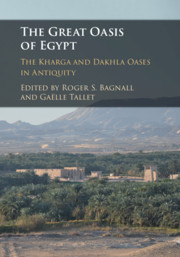Book contents
- The Great Oasis of Egypt
- The Great Oasis of Egypt
- Copyright page
- Contents
- Figures
- Tables
- Contributors
- Preface
- 1 Introduction
- Part I Living in the Oasis: Humans and the Environment
- Part II Managing the Oasis
- Part III Trade and Mobility in a Connected Environment
- Part IV An Oasis Culture?
- Bibliography
- Index of ancient people
- Index of places
- General index
Part III - Trade and Mobility in a Connected Environment
Published online by Cambridge University Press: 12 July 2019
- The Great Oasis of Egypt
- The Great Oasis of Egypt
- Copyright page
- Contents
- Figures
- Tables
- Contributors
- Preface
- 1 Introduction
- Part I Living in the Oasis: Humans and the Environment
- Part II Managing the Oasis
- Part III Trade and Mobility in a Connected Environment
- Part IV An Oasis Culture?
- Bibliography
- Index of ancient people
- Index of places
- General index
Summary
The oases of Kharga and Dakhla have been linked administratively from ancient times into the present. This chapter presents a study of the two main physical routes that connected the two oases: the Darb al-Ghubari and the Darb Ain Amur. Cairns, tracks, rock art, inscriptions, ceramics, and other small finds serve to identify the tracks and stopping points along the way. These paths, particularly the Darb Ain Amur, evolved over time, reflecting the changing environment and modes of transport that were used to make the journey from pharaonic to Roman times.
Keywords
- Type
- Chapter
- Information
- The Great Oasis of EgyptThe Kharga and Dakhla Oases in Antiquity, pp. 133 - 216Publisher: Cambridge University PressPrint publication year: 2019

